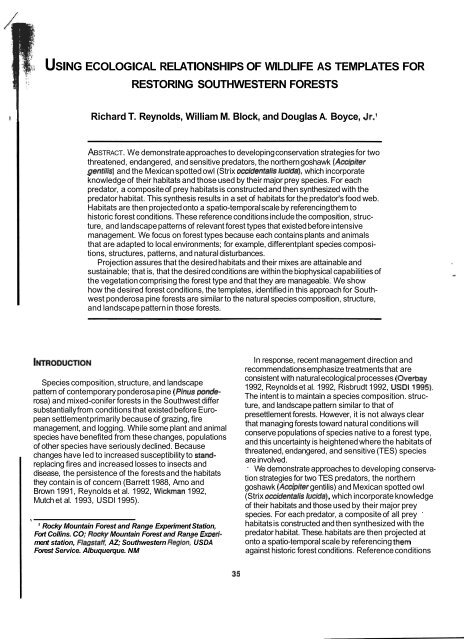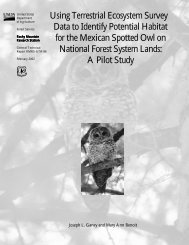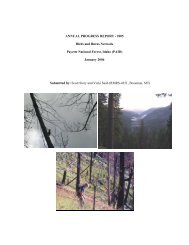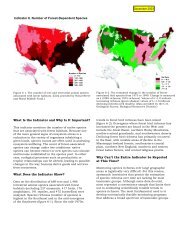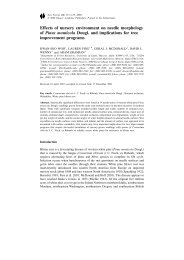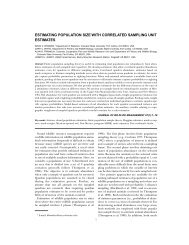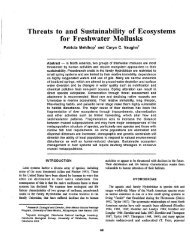Using ecological relationships of wildlife as templates for restoring ...
Using ecological relationships of wildlife as templates for restoring ...
Using ecological relationships of wildlife as templates for restoring ...
You also want an ePaper? Increase the reach of your titles
YUMPU automatically turns print PDFs into web optimized ePapers that Google loves.
i: USING ECOLOGICAL RELATIONSHIPS OF WILDLIFE AS TEMPLATES FOR<br />
RESTORING SOUTHWESTERN FORESTS<br />
Richard T. Reynolds, William M. Block, and Dougl<strong>as</strong> A. Boyce, Jr.l<br />
ABSTRACT. We demonstrate approaches to developing conservation strategies <strong>for</strong> two<br />
threatened, endangered, and sensitive predators, the northern goshawk (Accipiter<br />
gentilis) and the Mexican spotted owl (Strix occidentalis lucida), which incorporate<br />
knowledge <strong>of</strong> their habitats and those used by their major prey species. For each<br />
predator, a composite <strong>of</strong> prey habitats is constructed and then synthesized with the<br />
predator habitat. This synthesis results in a set <strong>of</strong> habitats <strong>for</strong> the predator's food web.<br />
Habitats are then projected onto a spatio-temporal scale by referencing them to<br />
historic <strong>for</strong>est conditions. These reference conditions include the composition, structure,<br />
and landscape patterns <strong>of</strong> relevant <strong>for</strong>est types that existed be<strong>for</strong>e intensive<br />
management. We focus on <strong>for</strong>est types because each contains plants and animals<br />
that are adapted to local environments; <strong>for</strong> example, different plant species compositions,<br />
structures, patterns, and natural disturbances.<br />
Projection <strong>as</strong>sures that the desired habitats and their mixes are attainable and<br />
sustainable; that is, that the desired conditions are within the biophysical capabilities <strong>of</strong><br />
the vegetation comprising the <strong>for</strong>est type and that they are manageable. We show<br />
how the desired <strong>for</strong>est conditions, the <strong>templates</strong>, identified in this approach <strong>for</strong> Southwest<br />
ponderosa pine <strong>for</strong>ests are similar to the natural species composition, structure,<br />
and landscape pattern in those <strong>for</strong>ests.<br />
Species composition, structure, and landscape<br />
pattern <strong>of</strong> contemporary ponderosa pine (Pinus ponderosa)<br />
and mixed-conifer <strong>for</strong>ests in the Southwest differ<br />
substantially from conditions that existed be<strong>for</strong>e European<br />
settlement primarily because <strong>of</strong> grazing, fire<br />
management, and logging. While some plant and animal<br />
species have benefited from these changes, populations<br />
<strong>of</strong> other species have seriously declined. Because<br />
changes have led to incre<strong>as</strong>ed susceptibility to standreplacing<br />
fires and incre<strong>as</strong>ed losses to insects and<br />
dise<strong>as</strong>e, the persistence <strong>of</strong> the <strong>for</strong>ests and the habitats<br />
they contain is <strong>of</strong> concern (Barrett 1988, Arno and<br />
Brown 1991, Reynolds et al. 1992, Wickman 1992,<br />
Mutch et al. 1993, USDl 1995).<br />
"<br />
Rocky Mountain Forest and Range Experiment Station,<br />
Fort Collins. CO: Rockv Mountain Forest and Ranae Exoeriment<br />
station, ~la~staff: AZ; Southwestern ~e~ion: USDA<br />
Forest Service. Albuquerque. NM<br />
In response, recent management direction and<br />
recommendations emph<strong>as</strong>ize treatments that are<br />
consistent with natural <strong>ecological</strong> processes (Overbay<br />
1992, Reynolds et al. 1992, Risbrudt 1992, USDl 1995).<br />
The intent is to maintain a species composition. structure,<br />
and landscape pattern similar to that <strong>of</strong><br />
presettlement <strong>for</strong>ests. However, it is not always clear<br />
that managing <strong>for</strong>ests toward natural conditions will<br />
conserve populations <strong>of</strong> species native to a <strong>for</strong>est type,<br />
and this uncertainty is heightened where the habitats <strong>of</strong><br />
threatened, endangered, and sensitive (TES) species<br />
are involved.<br />
- We demonstrate approaches to developing conservation<br />
strategies <strong>for</strong> two TES predators, the northern<br />
goshawk (Accipiter gentilis) and Mexican spotted owl<br />
(Strix occidentalis lucida), which incorporate knowledge<br />
<strong>of</strong> their habitats and those used by their major prey<br />
species. For each predator, a composite <strong>of</strong> all prey '<br />
habitats is constructed and then synthesized with the<br />
predator habitat. These. habitats are then projected at<br />
onto a spatio-temporal scale by referencing them<br />
against historic <strong>for</strong>est conditions. Reference conditions
include the composition, structure, and landscape patterns<br />
<strong>of</strong> relevant <strong>for</strong>est types be<strong>for</strong>e intensive management.<br />
This projection is critical <strong>for</strong> verifying that habitats<br />
and their desired mixes are attainable and sustainable;<br />
that is, that the desired conditions are within the biophysical<br />
capabilities <strong>of</strong> the vegetation comprising the<br />
<strong>for</strong>est type. Our approach establishes a set <strong>of</strong> desired<br />
<strong>for</strong>est conditions that vary by <strong>for</strong>est type because each<br />
<strong>for</strong>est type contains plants and animals that are adapted<br />
to local species compositions, structures, landscape<br />
patterns, and natural disturbances. This process gives<br />
us confidence that species will be conserved.<br />
Habitat provides the life needs <strong>of</strong> a species; a suitable<br />
microclimate, nest sites, food, escape cover, water, and<br />
mates. Thus, intrinsic and extrinsic <strong>relationships</strong> exist<br />
between a species and the physicgl and biological<br />
environment where it is found. These <strong>relationships</strong> partly<br />
underlay species evolution (Block and Brennen 1994).<br />
Native plants and animals <strong>of</strong> Southwestern <strong>for</strong>ests were<br />
adapted to environmental conditions that existed be<strong>for</strong>e<br />
the beginning <strong>of</strong> intensive <strong>for</strong>est management. Management<br />
prescriptions that restore the composition, structure,<br />
and spatial patterns <strong>of</strong> these <strong>for</strong>ests should improve<br />
the habitats <strong>of</strong> native species.<br />
Conservation strategies should consider all <strong>of</strong> a<br />
species' requisite resources (nesting and <strong>for</strong>aging<br />
habitats, food) and <strong>ecological</strong> <strong>relationships</strong> (competition,<br />
predators, dise<strong>as</strong>es) that might limit populations during<br />
any part their life histories. Furthermore, because<br />
habitats change through succession and natural and<br />
anthropogenic disturbances, conservation strategies<br />
should address the long-term sustainability <strong>of</strong> a species'<br />
habitat and the habitats <strong>of</strong> species in its food web. To<br />
sustain habitats and food resources, one must understand<br />
the habitat relationship <strong>of</strong> predator and prey and<br />
the dynamic physical, biological, and <strong>ecological</strong> processes<br />
that affect the sustainability <strong>of</strong> their <strong>for</strong>est<br />
habitats at large spatio-temporal scales. Our objective<br />
w<strong>as</strong> to design a landscape <strong>of</strong> sustaining habitats so that<br />
long-term goshawk and spotted owl viability w<strong>as</strong> <strong>as</strong>sured.<br />
The first step in developing our strategies w<strong>as</strong> to<br />
review the life histories <strong>of</strong> goshawks and spotted owls<br />
including their resource-use, population biology, and<br />
habitat ecology. Specifically, we:<br />
1. Reviewed how their populations might be limited by<br />
habitat, food, predators, competitors, and dise<strong>as</strong>es;<br />
2 Bamjned how environmental conditions,primarily<br />
vegetation, affect the distribution and abundance <strong>of</strong><br />
their habitats and influence the types and intensities<br />
<strong>of</strong> their intra- and interspecific <strong>relationships</strong>;<br />
3. Identified important prey <strong>for</strong> the goshawk and<br />
spotted owl within a <strong>for</strong>est type;<br />
4. Reviewed current knowledge on the key habitats<br />
and foods <strong>of</strong> their prey;<br />
5. Synthesized this in<strong>for</strong>mation into qualitative models<br />
b<strong>as</strong>ed on the desired abundance and spatial<br />
distribution <strong>of</strong> habitats <strong>of</strong> both predators and prey<br />
species; and<br />
6. Overlayed in<strong>for</strong>mation on the vegetation composition,<br />
structure, and landscape patterns <strong>of</strong> a <strong>for</strong>est<br />
type be<strong>for</strong>e intensive <strong>for</strong>est management to give<br />
these models a spatio-temporal context.<br />
Incorporating the ecology <strong>of</strong> a <strong>for</strong>est, including its<br />
patterns <strong>of</strong> growth and development, allowed us to<br />
design a shifting mosaic <strong>of</strong> predator and prey habitats<br />
that simulated the natural shifting mosaic. Our rationale<br />
is that <strong>for</strong>ests be<strong>for</strong>e Euro-American settlement were<br />
relatively stable in <strong>ecological</strong> time (Hansson 1977,<br />
Forman and Godran 1981, Romme and Knight 1982,<br />
Delcourt and Delcourt 1983). This stability allowed<br />
native plants and animals to adapt to local environments<br />
and to one another (Linhart 1989, Linhart et al. 1989).<br />
Managing these <strong>for</strong>ests within their natural ranges <strong>of</strong><br />
variation and <strong>ecological</strong> limits by using the natural<br />
compositions and abundances <strong>of</strong> fauna and flora and<br />
the processes that result in patterns <strong>of</strong> their <strong>as</strong>sembly, is<br />
the best model <strong>for</strong> sustaining these predators and their<br />
food webs.<br />
The shifting mosaic <strong>of</strong> habitats is achieved by matching,<br />
<strong>as</strong> closely <strong>as</strong> possible, the desired interspersion <strong>of</strong><br />
habitats with natural <strong>for</strong>est patch dynamics. Patch<br />
dynamics are the interacting consequences <strong>of</strong> the life<br />
span <strong>of</strong> trees, stand development characteristics,<br />
successional processes and patterns, and natural<br />
disturbances that vary in space and time in a <strong>for</strong>est type.<br />
The planning horizons <strong>for</strong> our conservation strategies<br />
are, there<strong>for</strong>e, centuries.<br />
Choosing the desired landscape<br />
Conservation strategies must identify appropriate<br />
spatial scales <strong>for</strong> providing and <strong>as</strong>sessing changes in<br />
the amount, quality, and intermixing <strong>of</strong> habitats to<br />
,<br />
maximize probabilities <strong>for</strong> population viability <strong>of</strong> the<br />
target species. The appropriate scale depends on<br />
management objectiyes and can be site-specific or<br />
encomp<strong>as</strong>s the entire geographic range <strong>of</strong> the species.<br />
For example, if the objective is to maintain only known<br />
pairs <strong>of</strong> goshawks, then the scale should be b<strong>as</strong>ed on<br />
the nesting home range, roughly 4,000 to 10,000 ac
.i;<br />
,@g and Gullion 1962, Reynolds 1983, Kennedy 1990,<br />
@gis et al. 1994, Bright-Smith and Mannan 1994).<br />
o ow ever, if the objective is to provide <strong>for</strong> growth <strong>of</strong> a<br />
population by providing favorable habitats <strong>for</strong> dispersing<br />
goshawks, then the appropriate scale may be an entire<br />
"ational <strong>for</strong>est or ecoregion. Implementing a large scale<br />
strategy also allows <strong>for</strong> the expansion <strong>of</strong> a predator's<br />
home range when prey population are low during winter<br />
and lessens the need to determine the "correct n number,<br />
, spatial configuration, and dispersal corridors between<br />
home ranges.<br />
The Mexican spotted owl in pine-oak and rnixedconifer<br />
<strong>for</strong>ests <strong>of</strong> the Southwest requires specific <strong>for</strong>est<br />
structures. Nest-stand structure typically includes large<br />
trees, closed-canopies, multiple-height strata, and log<br />
and snag decay (Zhou 1994, Ganey and Dick 1995,<br />
Seamans and Gutierrez 1995). Foraging habitats are<br />
more diverse; the consequence <strong>of</strong> <strong>for</strong>aging <strong>for</strong> prey<br />
species that have different habitat requirements<br />
(Reynolds et al. 1992. Ganey and Dick 1995). Foraging<br />
habitat includes multiple vegetation types and different<br />
seral stages (age cl<strong>as</strong>ses ) <strong>of</strong> those types. The size,<br />
shape, juxtaposition, and interspersion <strong>of</strong> habitat<br />
patches are <strong>as</strong> important to prey populations and to the<br />
<strong>for</strong>aging behavior <strong>of</strong> the goshawk or owl <strong>as</strong> the withinpatch<br />
characteristics. Furthermore, landscape considerations<br />
must allow <strong>for</strong> both short- and long-range dispersal.<br />
Short-range dispersal occurs within contiguous<br />
landscapes <strong>of</strong> connected or nearly connected habitats.<br />
On the other hand, long-range dispersal occurs between<br />
isolated patches <strong>of</strong> habitat, such <strong>as</strong> in the Sky Island<br />
region <strong>of</strong> southe<strong>as</strong>tern Arizona where the desired<br />
landscape may include stepping stone habitats that<br />
facilitate movement between these mountain islands.<br />
Conservation strategies must include nonbreeding and<br />
dispersal habitats because failure to do so may lead to<br />
decre<strong>as</strong>ed gene flow and genetic variation, and possibly<br />
to local extirpations.<br />
Identifying pre-settlement <strong>for</strong>est conditions<br />
Understanding the patterns and <strong>ecological</strong> processes<br />
that occurred in Southwestern ponderosa pine <strong>for</strong>ests<br />
be<strong>for</strong>e the introduction <strong>of</strong> intensive <strong>for</strong>estry w<strong>as</strong> central<br />
to our approach to developing conservation strategies.<br />
Sources <strong>of</strong> in<strong>for</strong>mation concerning historical conditions<br />
include historical accounts and photographs, tree rings,<br />
fire scars, packrat middens, are<strong>as</strong> that have had minimal<br />
human disturbance, dendrochronology, palynology,<br />
,. and paleo<strong>ecological</strong> and <strong>for</strong>est restoration studies<br />
(Kaufmann et al. 1993). Although numerous publications<br />
and reports describe the natural conditions <strong>of</strong> many<br />
North American <strong>for</strong>est types, the breadth and accuracy<br />
Of the in<strong>for</strong>mation is highly variable. The following is an<br />
abbreviated list <strong>of</strong> descriptions <strong>of</strong> the natural composition,<br />
structure, and landscape pattern <strong>of</strong> a variety <strong>of</strong><br />
<strong>for</strong>est types: ~oop'er (1960, l96l), Pearson (1%O),<br />
Billings (1969), Bormann and Likens (1979), Dieterich<br />
(1983)- Critchfield (198S), Barbour (1988). Elliott-Fisk<br />
(1988), Franklin (1988), Greller (1988). Peet (1988).<br />
Laudenslayer et at. (1989), Betancourt et al. (1990),<br />
Covington and Moore (1992), McKelevy and Johnson<br />
1992, Grissino-Meyer et al. (1994).<br />
LIMITA~ONS OF PRE-SE7TLEMENT DATA. Knowledge <strong>of</strong><br />
presettlement <strong>for</strong>est conditions is largely b<strong>as</strong>ed on<br />
correlative in<strong>for</strong>mation. Conclusions <strong>of</strong> studies b<strong>as</strong>ed on<br />
this in<strong>for</strong>mation <strong>for</strong> ponderosa pine consistently describe<br />
presettlement <strong>for</strong>ests <strong>as</strong> open, park-like are<strong>as</strong> composed<br />
<strong>of</strong> large trees that were strongly aggregated into<br />
groups. While much evidence supports this generalization,<br />
we are concerned with the degree that the results<br />
from these studies have been extrapolated. For example,<br />
Covington and Moore's (1992) study on the Bar-<br />
M canyon watershed <strong>of</strong> Arizona were on shallow slopes<br />
(0-15 percent) and included only one major soil type. We<br />
suspect that edaphic differences, topographic influences<br />
(especially <strong>as</strong>pect), and different fire regimes on steeper<br />
..<br />
slopes (>I5 percent) would have resulted in different<br />
densities, size-cl<strong>as</strong>s distributions, and species compositions<br />
<strong>of</strong> presettlement trees than on shallow slopes.<br />
Many studies <strong>of</strong> presettlement <strong>for</strong>ests provide few<br />
me<strong>as</strong>ures <strong>of</strong> dispersion, or in<strong>for</strong>mation on distributional<br />
properties <strong>of</strong> the parameters estimated. Whether or not<br />
sample sizes in some studies were sufficient <strong>for</strong> unbi<strong>as</strong>ed<br />
estimates <strong>of</strong> the mean number <strong>of</strong> trees cannot be<br />
evaluated without in<strong>for</strong>mation on sampling variances:<br />
sample sizes in most studies were+small. While previous<br />
work h<strong>as</strong> heuristic value in verifying.certain <strong>for</strong>est<br />
conditions, we caution about the extrapolation <strong>of</strong> these<br />
results in complex landscapes.<br />
Northern goshawk<br />
Ponderosa pine in the Southwest (about 2.8 million<br />
ac) occurs between the dry.pinyon-juniper or oak<br />
woodlands arid the cool, moist mixed-conifer <strong>for</strong>ests at<br />
higher elevations, between 6,500 and 8,500 feet elevation.<br />
Within the ponderosa pine zone, the tree occurs<br />
either in pure stands where it typically is'the climax<br />
species, or in mixed-species stands where it is <strong>of</strong>ten<br />
seral. At lower ,elevations it frequently mixes with pinyon<br />
pine, several species <strong>of</strong> juniper, and oak; at higher<br />
elevations it mixes with Dougl<strong>as</strong>-fir, white fir, blue .<br />
spruce, southwestern white pine, and quaking <strong>as</strong>pen<br />
(Barrett et al. 1980). Frequent (every 2-7 years) lowintensity<br />
ground fires maintained open, park-like <strong>for</strong>ests<br />
visually dominated by large yellow-barked pines that<br />
occurred in small groups (< 0.3 ac) <strong>of</strong> trees(Covington
and Moore 1992). Adjacent groups <strong>of</strong> trees typically<br />
differed in ages (Weaver 1951, Cooper 1961, Dieterich<br />
1983, Swetnam and Dieterich 1985). Intensive livestock<br />
grazing since the late 19th century, and fire suppression<br />
and timber harvests since the early 1900s, have greatly<br />
altered the species composition <strong>of</strong> understory and<br />
overstory vegetation, soil characteristics, tree densities,<br />
fire fuel loadings, tree vigor, and <strong>wildlife</strong> habitat (Cooper<br />
1960, Faulk 1970, Covington and Sackett 1984, White<br />
1985, Covington and Moore 1992, Reynolds et al. 1992).<br />
PREY AND HABITATS. The following is a SUmmary <strong>of</strong><br />
the current knowledge <strong>of</strong> goshawk and prey habitats<br />
historical composition, structure, pattern, and disturbance<br />
in Southwest ponderosa pine <strong>for</strong>ests. The complete<br />
conservation strategy <strong>for</strong> the goshawk in this <strong>for</strong>est<br />
type is in Reynolds et al. (1 992). Fourteen prey species<br />
(or groups <strong>of</strong> similar species), b<strong>as</strong>ed on their numerical<br />
and biom<strong>as</strong>s contribution to diets, were selected <strong>as</strong><br />
important prey (Table 1). The majority <strong>of</strong> these prey<br />
reside on the ground or in the lower portions <strong>of</strong> the tree<br />
canopy. All <strong>of</strong> the mammals, and many <strong>of</strong> the avian<br />
prey, feed on seeds, berries, or the foliage <strong>of</strong> herbaceous<br />
and shrubby plants that occur in the <strong>for</strong>est<br />
understory or in small <strong>for</strong>est openings. Many feed on<br />
pollen and seeds <strong>of</strong> staminate and ovulate cones <strong>of</strong><br />
conifers. Tree squirrels, <strong>for</strong> example, climb trees <strong>for</strong><br />
cones, while chipmunks and ground squirrels scavenge<br />
cones or seeds from the ground or steal cones from<br />
caches <strong>of</strong> others. Other prey species eat arthropods that<br />
feed on understory plants or on trees, or that nest in<br />
downed logs or in the soil. Mycorrhizal soil fungi are<br />
important foods <strong>for</strong> many <strong>of</strong> the mammalian prey.<br />
Snags (standing dead trees) provide critical resources<br />
<strong>for</strong> many birds, mammals, invertebrates, and plants.<br />
Among goshawk prey, all woodpeckers use snags <strong>for</strong><br />
feeding, nesting, or both. Several other species <strong>of</strong> birds<br />
use snags <strong>for</strong> perches. Four mammals use snags with<br />
cavities <strong>for</strong> nesting and <strong>for</strong> caching cones.<br />
Large, downed logs provide cover, feeding, and nest<br />
sites <strong>for</strong> a variety <strong>of</strong> vertebrates. Among goshawk prey,<br />
TABLE 1. Suite <strong>of</strong> important northern goshawk prey in the<br />
Southwest (from Reynolds et al. 1992).<br />
Birds<br />
American robin<br />
Band-tailed pigeon<br />
Blue grouse<br />
Hairy woodpecker<br />
Mourning dove<br />
Northern flicker<br />
Red-naped sapsucker<br />
Steller's jay<br />
Williamson's sapsucker<br />
Mammals<br />
Chipmunks (Tamius spp.)<br />
Cottontail (Sylvilagus spp.)<br />
Mantled ground squirrel<br />
Red squirrel<br />
T<strong>as</strong>sel-eared squirrel<br />
downed logs are important feeding sites <strong>for</strong> woodpeckers<br />
and <strong>as</strong> denning sites <strong>for</strong> chipmunks, mantled ground<br />
squirrels, and cottontail rabbits. Downed logs are also<br />
used by blue grouse during courtship.<br />
The character, amount, and distribution <strong>of</strong> woody<br />
debris (material >3 in. and 42<br />
in. in diameter) may<br />
affect the abundance <strong>of</strong> goshawk prey (Dimock 1974).<br />
woody debris provides important denning sites <strong>for</strong><br />
cottontail rabbits, cover <strong>for</strong> rabbits, chipmunks, and<br />
ground squirrels, and feeding sites <strong>for</strong> several woodpecker<br />
species.<br />
Large trees (>I8 in. in diameter) provide critical<br />
nesting, denning, feeding, and roosting sites <strong>for</strong> such<br />
goshawk prey <strong>as</strong> t<strong>as</strong>sel-eared squirrels, large woodpeckers,<br />
and blue grouse. Large trees also are good<br />
cone producers, providing seed <strong>for</strong> many prey species.<br />
Large trees are the only source <strong>for</strong> large snags and<br />
downed logs, both important to all but one member <strong>of</strong><br />
the suite <strong>of</strong> prey. Large trees also provide hunting<br />
perches and nest trees <strong>for</strong> goshawks.<br />
Openings with their <strong>as</strong>sociated gr<strong>as</strong>sy, herbaceous,<br />
or shrubby vegetation, provide important food and cover<br />
<strong>for</strong> a number <strong>of</strong> goshawk prey. Three species require<br />
openings; blue grouse <strong>for</strong> nesting and brood-rearing,<br />
and band-tailed pigeons and mourning doves <strong>for</strong> feeding.<br />
Because pigeons and doves typically travel long<br />
distances to feed, large openings may not be necessary<br />
<strong>for</strong> them. Small to medium openings (
dove) are generalists and occur in most VSSs, while<br />
others, such <strong>as</strong> Williamson's sapsucker, occur in a<br />
limited number <strong>of</strong> structural stages. Blue grouse need<br />
older <strong>for</strong>ests (VSS 4,5, and 6) interspersed with openings<br />
(VSS I), and t<strong>as</strong>sel-eared squirrels need a mix <strong>of</strong><br />
rnid-aged and mature or old <strong>for</strong>ests.<br />
Many <strong>of</strong> the mammalian prey species depend on<br />
fungi during summer and fall; the physiological condition<br />
in which tree squirrels begin the winter depends on the<br />
amount <strong>of</strong> fungi eaten (M<strong>as</strong>er et al. 1978). In ponderosa<br />
pine <strong>for</strong>ests, the best fungi-producers are mid-aged VSS<br />
with high canopy cover and shade to protect soil moisture<br />
(States 1985, States et al. 1988, Uph<strong>of</strong>f 1990).<br />
Mexican spotted owl<br />
The Mexican spotted owl w<strong>as</strong> listed <strong>as</strong> a threatened<br />
species in 1993 under the Endangered Species Act<br />
(1973) and a team w<strong>as</strong> <strong>for</strong>med to develop a recovery<br />
plan (USDI 1995). Summarized below are features <strong>of</strong><br />
the recovery plan that characterize habitat needs <strong>for</strong> the<br />
owl and its prey.<br />
PREY AND HABITATS. Seven groups <strong>of</strong> vertebrates,<br />
including more than 16 species, are important prey <strong>for</strong><br />
owls b<strong>as</strong>ed on comprising >10 percent <strong>of</strong> the diet by<br />
either frequency or biom<strong>as</strong>s (Table 2). Although the<br />
owl's diet varies geographically, woodrats (Neotoma<br />
spp.) and peromyscid mice (Peromyscus spp.) usually<br />
dominate the diet. Even so, the species taken <strong>as</strong> prey<br />
represent a diverse array <strong>of</strong> habitats and <strong>ecological</strong><br />
niches. Considered <strong>as</strong> a group, they demonstrate the<br />
importance <strong>of</strong> managing <strong>for</strong> a landscape mosaic consisting<br />
<strong>of</strong> habitat patches in various conditions and seral<br />
stages.<br />
Although the owl is found predominantly in mixedconifer<br />
<strong>for</strong>ests, some reside in ponderosa pine-Gambel<br />
oak <strong>for</strong>ests <strong>of</strong> northern Arizona. By biom<strong>as</strong>s, the most<br />
common prey in these <strong>for</strong>ests are woodrats (N.<br />
mexicana and N. albigula), peromyscid mice (P.<br />
maniculatus and P. boyli~), cottontail (Sylvilagus nut tall^),<br />
and various sciurids (Spemophilus lateralis, S.<br />
variegatus, Tami<strong>as</strong> dorsalis, T. cinereicollus). Lesser<br />
components <strong>of</strong> the diet include various bird species,<br />
pocket gophers (Thomomys spp), Mexican voles<br />
(Microtus mexicanus), bats, and arthropods.<br />
Habitat requirements <strong>for</strong> each <strong>of</strong> these species are<br />
unique. The deer mouse inhabits most are<strong>as</strong>, where<strong>as</strong><br />
the brush mouse and Mexican woodrat favor are<strong>as</strong> with<br />
rocky outcrops, high log volume, and a shrub understory.<br />
Such conditions occur frequently, but not exclusively,<br />
on poor timber producing sites. Cottontail, pocket<br />
gophers, and voles use more open are<strong>as</strong> where sDarse<br />
canopy cover allows <strong>for</strong> a well-developed herbacebus<br />
understory. These are<strong>as</strong> typically occur within stands,<br />
along drainages and canyon bottoms, or in meadows<br />
adjacent to <strong>for</strong>ests. Curiously, voles contributed little to<br />
the total diet <strong>of</strong> owls in the pine-oak <strong>for</strong>est, although they<br />
are a major diet component in other parts <strong>of</strong> the owl's<br />
range (Ward and Block 1995). The low number <strong>of</strong> voles<br />
TABLE 2. Prey comprising >lo% <strong>of</strong> relative frequency (X) or blon n<strong>as</strong>s (0) In the diet <strong>of</strong> Mexican spotted owls (from USDI 1995).<br />
--<br />
Southern Southern Sierra<br />
Rocky Rocky Upper B<strong>as</strong>in & B<strong>as</strong>in & Madre<br />
Colorado Mountains Mountains Gila Range Range Occidental<br />
Prey group Plateau Colorado New Mexico Mts. West E<strong>as</strong>t Norte<br />
Bats<br />
Rabbits<br />
Pocket gophers<br />
Perornycid mice<br />
Deer mouse<br />
Brush mouse<br />
Canyon mouse<br />
Woodrats<br />
Mexican woodrat<br />
Bushy-tailed woodrat<br />
Desert woodrat<br />
White-throated woodrat<br />
Voles<br />
Mexican vole<br />
, Mountain vole<br />
Meadow vole<br />
Long-tailed vole<br />
Birds<br />
Arthropods<br />
' Undetermined.<br />
3 9
in the diet w<strong>as</strong> corroborated by low numbers captured<br />
during live-trap sampling (Block and Ganey, unpubl.<br />
data). Possibly the unnaturally dense conditions <strong>of</strong> these<br />
<strong>for</strong>ests (Covington and Moore 1992) have suppressed<br />
the growth <strong>of</strong> gr<strong>as</strong>ses and <strong>for</strong>bs decre<strong>as</strong>ing habitat<br />
quality and quantity <strong>for</strong> species like voles, gophers, and<br />
rabbits.<br />
Providing appropriate habitat conditions <strong>for</strong> prey<br />
species is critical <strong>for</strong> buffering predator populations<br />
against natural population declines in any prey species.<br />
Given the variety <strong>of</strong> prey taken and differences among<br />
prey species in habitat requirements, the desired<br />
landscape should be a mosaic consisting <strong>of</strong> vegetation<br />
in different conditions and seral stages. These prey<br />
species are adapted to natural conditions in Southwestern<br />
<strong>for</strong>ests; thus, returning these <strong>for</strong>ests to more natural<br />
conditions will help ensure an adequate prey b<strong>as</strong>e <strong>for</strong><br />
the Mexican spotted owl.<br />
Templates: Desired <strong>for</strong>est conditions<br />
NORTHERN GOSHAWK.<br />
Our analysis showed that<br />
goshawk <strong>for</strong>aging habitat consisted <strong>of</strong> large trees and<br />
relatively open understories. Large trees have large<br />
limbs that are used <strong>as</strong> hunting perches, and relatively<br />
open understories provide flight room and opportunities<br />
<strong>for</strong> detecting and capturing prey. Habitat <strong>for</strong> goshawk<br />
prey in Southwestern ponderosa pine <strong>for</strong>ests included<br />
small, scattered openings and a high interspersion <strong>of</strong><br />
age cl<strong>as</strong>ses to provide a diversity <strong>of</strong> habitats and foods.<br />
On average, canopy cover w<strong>as</strong> relatively open, allowing<br />
sunlight and moisture to reach the <strong>for</strong>est floor so that<br />
gr<strong>as</strong>sy, herbaceous, or shrubby understories could<br />
develop. However, groups <strong>of</strong> trees within patches <strong>of</strong><br />
VSS 5 & 6 had interlocking crowns and higher (60-80<br />
percent) canopy cover. Interlocking crowns provided<br />
travel routes <strong>for</strong> squirrels (Patton 1984) and other prey,<br />
and shading to protect soil moisture and fungi populations<br />
(States 1985). Large tree components (live trees,<br />
snags, and downed logs) were abundant and scattered<br />
throughout the landscape. Large live trees provided<br />
many unique hiding, feeding, denning, and nesting sites<br />
used during some part <strong>of</strong> the annual cycle <strong>of</strong> all important<br />
goshawk prey species. Goshawk habitat in ponderosa<br />
pine should have abundant prey when at le<strong>as</strong>t 60<br />
percent <strong>of</strong> the landscape is in the three older age<br />
cl<strong>as</strong>ses (VSS 4,5, and 6).<br />
The desired habitats <strong>of</strong> goshawks and their prey in<br />
. ponderosa pine consisted <strong>of</strong> a mosaic <strong>of</strong> highly interspersed,<br />
small patches <strong>of</strong> different structural stages<br />
(gr<strong>as</strong>s/<strong>for</strong>b/shrub stage to old <strong>for</strong>est stage). This mosaic<br />
<strong>of</strong> <strong>for</strong>est patches and within-patch structure closely<br />
resembled the species composition, structure, and<br />
landscape pattern in historic Southwestern ponderosa<br />
pine <strong>for</strong>ests. Mature and old trees in these pine <strong>for</strong>ests<br />
were strongly aggregated into groups consisting <strong>of</strong> 3 to<br />
44 trees and occupied from 0.5 to 0.7 ac (Cooper 1961,<br />
White 1985). Groups were typically separated by variably-sized<br />
openings. Although openings appeared<br />
unstocked, the roots <strong>of</strong> trees in the groups extended 50<br />
feet or more into the openings (Pearson 1950). Tree<br />
reproduction (seedlings, saplings, poles) either occurred<br />
within a group, <strong>of</strong>ten when a mature tree fell (Covington<br />
and Moore 1 %2), or in openings between groups<br />
(Pearson 1950, Cooper 1961). Seedlings were established<br />
in a year when fire exposed the mineral soil seed<br />
bed and when there w<strong>as</strong> high seed production and<br />
rainfall (Cooper 1960, 1961 ). The historical ponderosa<br />
pine <strong>for</strong>est landscape w<strong>as</strong> composed <strong>of</strong> an all-aged<br />
<strong>for</strong>est (coarse scale) made up <strong>of</strong> small, either even-aged<br />
or multi-aged patches <strong>of</strong> trees (fine scale).<br />
Interlocking tree crowns, large limbs in and below<br />
crowns, and extensive shading are important withinpatch<br />
characteristics <strong>for</strong> goshawks and their prey. Yet<br />
trees in these patches should be vigorous enough to<br />
produce abundant symbiotic mycorrhizal fungi. Trees<br />
within groups <strong>of</strong> mature ponderosa pine display the<br />
characteristics <strong>of</strong> open-grown trees and trees grown in<br />
dense stands. Interior trees are under greater competition<br />
<strong>for</strong> soil moisture, nutrients, and light, where<strong>as</strong> trees<br />
on group edges have more sunlight and openings to<br />
spread their roots (Pearson 1950). While interior trees<br />
have narrow and short crowns, trees on the edge have<br />
one-sided but long crowns. Further, the crowded conditions<br />
within groups result in an intermingling <strong>of</strong> adjacent<br />
trees limbs. The long crowns <strong>of</strong> the outside trees provide<br />
shading and maintain higher soil moisture within the<br />
group, which are conditions ideal <strong>for</strong> mycorrhizal fungi<br />
production (States 1985, States et al. 1988, Uph<strong>of</strong>f 1990).<br />
Large diameter snags were historically abundant and<br />
well dispersed in Southwestern ponderosa <strong>for</strong>ests<br />
because <strong>of</strong> the abundance and susceptibility <strong>of</strong> old trees<br />
to mortality factors such <strong>as</strong> wind, lightning, fire, mistletoe,<br />
fungal dise<strong>as</strong>es, insects and other herbivores<br />
(Pearson 1950, Cooper 1961 ). Although frequent ground<br />
fires kept the <strong>for</strong>est floor relatively clear <strong>of</strong> woody debris,<br />
portions <strong>of</strong> large diameter logs <strong>of</strong>ten survived fires.<br />
These large trees and snags provided a continuing<br />
source <strong>of</strong> large-log habitats <strong>for</strong> goshawk prey.<br />
The goshawk conservation strategy identified the<br />
proportions <strong>of</strong> managed landscapes that could be<br />
maintained in specified age cl<strong>as</strong>ses so that the availabib<br />
ity <strong>of</strong> those age cl<strong>as</strong>ses would remain somewhat con-'<br />
stant through time. For the goshawk, this objective w<strong>as</strong><br />
met when a landscape had 20 percent in each <strong>of</strong>4he<br />
older four age cl<strong>as</strong>ses (VSS 3,4,5,6) and 10 percent<br />
each in VSS 1 and 2. The proportions that can be<br />
maintained in the different age cl<strong>as</strong>ses depends on the i<br />
number <strong>of</strong> years required <strong>for</strong> seedling establishment,<br />
growth rate <strong>of</strong> trees (partly dependent on the intensity <strong>of</strong><br />
management), and tree longevity.<br />
I
MEXEAN SPOTTED OWL. Similar to the desired conditions<br />
<strong>for</strong> goshawks, the <strong>for</strong>ested landscape <strong>for</strong> Mexican<br />
spotted owls and their prey in ponderosa pine-Gambel<br />
oak and mixed-conifer <strong>for</strong>ests should emph<strong>as</strong>ize a<br />
mosaic <strong>of</strong> different seral stages. Although the interspersion<br />
and juxtaposition <strong>of</strong> patches w<strong>as</strong> unknown, a key<br />
consideration w<strong>as</strong> the distribution <strong>of</strong> seral stages <strong>as</strong> they<br />
relate to topography, specifically slope and <strong>as</strong>pect.<br />
Presently, most owl nest and roost sites in this <strong>for</strong>est<br />
type are on steep slopes <strong>as</strong>sociated with cinder cones<br />
and drainages. Whether or not presettlement <strong>for</strong>est<br />
conditions on these slopes differed from those on flatter<br />
slopes is unknown. However, because <strong>of</strong> edaphic and<br />
microclimatic differences, and possibly differences in fire<br />
regimes, <strong>as</strong>suming that presettlement <strong>for</strong>est structure<br />
varied with slope and <strong>as</strong>pect is re<strong>as</strong>onable. Research is<br />
needed to describe the variations in presettlement <strong>for</strong>est<br />
structure <strong>as</strong> influenced by environmental differences.<br />
The limiting factor <strong>for</strong> owls is adequate nest and roost<br />
habitat. Typically, such habitat exhibits high tree b<strong>as</strong>al<br />
area, large trees, and a large oak component. Most<br />
nests in this <strong>for</strong>est type are in cavities <strong>of</strong> large Gambel<br />
oaks. Garnbel oak are shade intolerant, thus they<br />
require an open canopy structure to become established<br />
and achieve maximum growth potential. The size <strong>of</strong> nest<br />
stands is unknown but is currently under investigation<br />
(R. Gutierrez, personal communication with W. Block).<br />
However, the Forest Service stand datab<strong>as</strong>e indicates<br />
that 7 to 10 percent <strong>of</strong> pine-oak <strong>for</strong>ests meet nest stand<br />
characteristics (USDI 1995). Whether or not stands<br />
exhibiting nest characteristics existed be<strong>for</strong>e European<br />
settlement and, if so, what proportion <strong>of</strong> the landscape<br />
contained these conditions, is unknown, but should be<br />
researched. The remainder <strong>of</strong> the landscape should<br />
include stands <strong>of</strong> various seral stages to meet the<br />
habitat requirements <strong>of</strong> the prey the owl requires. The<br />
distribution <strong>of</strong> seral stages and mosaic patterns required<br />
by the goshawk in pine <strong>for</strong>ests appear compatible with<br />
spotted owl needs. We <strong>as</strong>sume that species in both the<br />
owl and goshawk food webs are adapted to natural<br />
conditions; there<strong>for</strong>e, even partial restoration <strong>of</strong> those<br />
conditions will improve their habitats.<br />
conditions varies across sites and that this variation is<br />
<strong>as</strong>sociated with elevation, slope, <strong>as</strong>pect, soil, and<br />
moisture and nutrient availability. During implementation,<br />
we suggest the best reference conditions <strong>for</strong> sustaining<br />
habitats on sites are the historical species compositions,<br />
densities, and patterns on those sites.<br />
Present <strong>for</strong>est conditions are moving away from<br />
histbric conditions; many <strong>of</strong> the recommendations in our<br />
conservation strategies reverse that direction. Specific<br />
management prescriptions <strong>for</strong> Southwestern ponderosa<br />
pine were designed to improve predator and prey<br />
habitats by:<br />
1. Incre<strong>as</strong>ing the abundance <strong>of</strong> old trees and <strong>for</strong>ests,<br />
large snags, and large, downed logs;<br />
2. Restoring the grouped nature <strong>of</strong> trees and the<br />
interspersion <strong>of</strong> small patches <strong>of</strong> different age<br />
cl<strong>as</strong>ses;<br />
3. Restoring the habitats and foods provided by a<br />
well-developed gr<strong>as</strong>s, <strong>for</strong>b, and shrub layer in<br />
understories; and<br />
4. Protecting habitats from cat<strong>as</strong>trophic loss from fire<br />
and insect epidemics by reducing fuel ladders and<br />
tree overstocking.<br />
Some recommended tools to attain these goals are<br />
small group-selection (uneven-aged management),<br />
retention <strong>of</strong> large snags and logs, protection <strong>of</strong> the<br />
organic surface layer <strong>of</strong> soils during management<br />
activities, lengthening the harvest cycle, thinning from<br />
below, and the reintroduction <strong>of</strong> ground fires (Reynolds<br />
et al. 1992, USDI 1995).<br />
We thank Suzanne M. Joy and Wayne D. Shepperd<br />
<strong>for</strong> their critical reviews <strong>of</strong> the manuscript. Many <strong>of</strong> the<br />
ide<strong>as</strong> in this paper resulted from team ef<strong>for</strong>ts by the<br />
Goshawk Scientific Committee and Mexican Spotted<br />
Owl Recovery Team; we wish to acknowledge their<br />
contributions to the content <strong>of</strong> this paper.<br />
Implementation<br />
A conservation strategy is not complete without are<strong>as</strong>pecific<br />
guidelines <strong>for</strong> its implemention. Attainment <strong>of</strong><br />
the desired conditions requires an understanding <strong>of</strong> the<br />
relationship between existing <strong>for</strong>est conditions, the<br />
desired conditions, and the landb<strong>as</strong>e capability. The<br />
' choice and intensity <strong>of</strong> management should be b<strong>as</strong>ed on<br />
the direction and the distance the existing <strong>for</strong>est conditions<br />
must move to reach the desired conditions. Both<br />
Reynolds et al. (1 992) and the USDI (1 995) recognized<br />
that the capability <strong>of</strong> a landb<strong>as</strong>e to produce certain <strong>for</strong>est<br />
Arno, S. F., and Brown, J. K. 1991. overcoming the<br />
paradox in managing wildland fire. Western Wildlands<br />
17:40-46.<br />
Barbour, M. G. 1988. Cali<strong>for</strong>nian upland <strong>for</strong>ests and<br />
woodlands. Pages 131-1 64, In: Barbour, M. G., and<br />
Billings, W. D., eds.; North American Vegetation.<br />
Cambridge Univ. Press.<br />
Barrett, J. W., McDonald, P. M., Ronco, F., Jr., and<br />
Ryker, R. A. 1980. Interior ponderosa pine. In:: Eyre,<br />
F. H., ed. Forest cover types <strong>of</strong> the United States and
Canada. W<strong>as</strong>hington, DC: Society American For:<br />
114-115.<br />
Barrett, S. W. 1988. Fire suppression's effects on <strong>for</strong>est<br />
succession within a central Idaho wilderness. Western<br />
Journal <strong>of</strong> Applied Forestry 3: 76-80.<br />
Betancourt, J. L., Van Devender, T. R., and Martin, P. S.<br />
1990. Packrat middens: the l<strong>as</strong>t 40,000 years <strong>of</strong> biotic<br />
change. University <strong>of</strong> Arizona Press. 467 pp.<br />
Billings, W. D. 1969. Vegational pattern near alpine<br />
timberline <strong>as</strong> affected by fire-snowdrift interactions.<br />
Vegetation l9:192-207.<br />
Block, W. M., and Brennen, L. A. 1994. The habitat<br />
concept in ornithology. Current Ornithology. 11 :35-91.<br />
Bormann, F. H., and Likens, G. E. 1979. Pattern and<br />
process in a <strong>for</strong>ested ecosystem. Springer-Verlag, NY.<br />
Bright-Smith, D. J., and Mannan, R. W. 1994. Habitat<br />
use by breeding male northern goshawks. Studies in<br />
Avian Biology. 1658-65.<br />
Cooper, C. F. 1960. Changes in vegetation, structure,<br />
and growth <strong>of</strong> southwestern pine <strong>for</strong>est since white<br />
settlement. Ecological Monographs. 30: 129-164.<br />
Cooper, C. F. 1961. Pattern in ponderosa pine <strong>for</strong>ests.<br />
Ecology 42:493-499.<br />
Covington, W. W., and Moore, M. M. 1992.<br />
Postsettlement changes in natural fire regimes:<br />
implications <strong>for</strong> restoration <strong>of</strong> old-growth ponderosa<br />
pine <strong>for</strong>ests. In: Kaufmann, M. R.; Moir, W. H.;<br />
B<strong>as</strong>sett, R. L., tech. eds. Old-growth <strong>for</strong>ests in the<br />
Southwest and Rocky Mountain Regions: proceedings<br />
<strong>of</strong> a workshop. Gen. Tech. Rep. RM-213. Fort<br />
Collins, CO: U.S. Department <strong>of</strong> Agriculture, Forest<br />
Service, Rocky Mountain Forest and Range Experiment<br />
Station. 81 -99 p.<br />
Covington, W. W., and Sackett, S. S. 1984. The effect <strong>of</strong><br />
a prescribed burn in southwestern ponderosa pine on<br />
organic matter and nutrients in woody debris on <strong>for</strong>est<br />
floor. Forest Science. 30:183-192.<br />
Critchfield, W. B. 1985. The late Quaternary history <strong>of</strong><br />
lodgepole and jack pines. Can. J. Forest Res. 15:749-<br />
772.<br />
Delcourt, P. A., and Delcourt, H. R. 1983. Late quaternary<br />
vegetational dynamics and community stability<br />
reconsidered. Quat. Res. 19:265-271.<br />
Dieterich, J. H. 1983. Fire history <strong>of</strong> southwestern<br />
mixed-conifer: a c<strong>as</strong>e study. Forestry Ecology Management.<br />
6:13-31.<br />
Dimock, E. J., 111. 1974. Animal populations and damage.<br />
In: Environmental effects <strong>of</strong> <strong>for</strong>est residues<br />
management in the Pacific Northwest: a state-<strong>of</strong>knowledge<br />
compendium. Gen. Tech. Rep. PNW-24.<br />
%<br />
Portland,<br />
OR: Pacific Northwest Forest and Range<br />
Experiment Station. 0-1 to 0-28.<br />
Eng, R. L., and Gullion, G. W. 1962. The predation <strong>of</strong><br />
goshawks upon ruffed grouse on the Cloquet Forest<br />
Research Center, Minnesota. Wilson Bulletin. 74:227-<br />
242.<br />
Elliot-Fisk, D. L. 1988. The boreal <strong>for</strong>est. Pages 34-62,<br />
In: Barbour, M. G., and Billings, W. D., eds., North<br />
American Vegetation. Cambridge Univ. Press.<br />
Faulk, 0. B. 1970. Arizona: a short history. Norman:<br />
University <strong>of</strong> Oklahoma Press. 266 p.<br />
Forman, R. T. T., and Godran, M. 1981. Patches and<br />
structural components <strong>for</strong> a landscape ecology.<br />
Bioscience 31 :733-740.<br />
Franklin, J. F. 1988. Pacific northwest <strong>for</strong>ests. Pages<br />
104-130, In: Barbour, M. G., and Billings, W. D., eds.,<br />
North American Vegetation. Cambridge Univ. Press.<br />
Ganey, J. L., and J. L. Dick, Jr. 1995. Habitat <strong>relationships</strong><br />
<strong>of</strong> the Mexican spotted owl. Chapter 4 In: USDI,<br />
Recovery plan <strong>for</strong> the Mexican spotted owl. Vol. It.<br />
Albuquerque, NM.<br />
Greller, A. M. 1988. Deciduous <strong>for</strong>ests. Pages 288-316,<br />
In: Barbour, M. G., and Billings, W. D., eds., North<br />
American Vegetation. Cambridge Univ. Press.<br />
Grissino-Meyer, H. D., Baisan, C. H., and Swetnam, T.<br />
W. 1994. Fire history in the Pinaleno Mountains <strong>of</strong><br />
southe<strong>as</strong>tern Arizona: effects <strong>of</strong> human-related<br />
disturbances. Pages 399-407, In: Biodiversity and ,<br />
Management <strong>of</strong> the Madrean Archipelago: The Sky<br />
Islands <strong>of</strong> Southwestern United States and Northwestern<br />
Mexico, DeBano, L. F., Gottfried, G. J.,<br />
Hamre, R. H., Ffollitt, P. F., and Ortega- Rubio, A.,<br />
Technical Coordinators. USDA Forest Service, Gen.<br />
Tech. Rep. RM-GTR-264. Rocky Mountain Forest<br />
and Range Experiment Station, Fort Collins, CO.<br />
Hargis, C. D., McCarthy, C., and Perl<strong>of</strong>f, R. D. 1994.<br />
Home ranges and habitats <strong>of</strong> northern goshawks in<br />
e<strong>as</strong>tern Cali<strong>for</strong>nia. Studies in Avian Biology. 16:66-74.<br />
Hansson, L. 1977. Landscape ecolpgy and the stability<br />
<strong>of</strong> populations. Landscape Planning 4:85-93.<br />
Kennedy, P. L. 1990. Home ranges <strong>of</strong> northern goshawks<br />
nesting in north-central New Mexico. In:<br />
Krausman, P. R.; Smith, N. S., eds. Managing <strong>wildlife</strong><br />
in the southwest symposium. Tuscon, AZ: 259.<br />
Kaufmann, M. R.; Graham, R. T.; Boyce, Jr., D. A.; Moir,<br />
W. H.; Perry, L.; Reynolds, R. T.; B<strong>as</strong>sett, R. L.;<br />
Melhop, P.; Edminster, C. D.; Block, W.M.; Corn, P.<br />
S. 1994. An <strong>ecological</strong> b<strong>as</strong>is <strong>for</strong> ecosystem management.<br />
USDA Forest Service, Rocky Mountain Forest<br />
and Range Experiment Station, Fort Collins, GO.<br />
General Technical Report RM-246.<br />
Laudenslayer, W. F., Jr., Darr, H. H., and Smith, S.<br />
1989. Historical effects <strong>of</strong> <strong>for</strong>est management prac- . '<br />
tices on e<strong>as</strong>tside pine communities in northe<strong>as</strong>tern<br />
Cali<strong>for</strong>nia. Pages 26-34, In: Multiresouce Management<br />
<strong>of</strong> Ponderosa Pine Forests. Tecle, A.,<br />
Covington, W. W., and R. H. Hamre, Technical<br />
Coordinators. USDA Forest Service, Gen. Tech. Rep.<br />
RM-185, Rocky Mountain Forest and Range Experiment<br />
Station, Fort Collins, CO.<br />
Linhart, Y. B. 1989. Interactions between genetic and<br />
<strong>ecological</strong> patchiness in <strong>for</strong>est trees and their depen-
dent species. In: The evolutionary ecology <strong>of</strong> plants:<br />
393-430.<br />
inh hart, Y. B.; Snyder, M. A.; Habeck, S. A. 1989. The<br />
influence <strong>of</strong> animals on the genetic variability within<br />
ponderosa pine stands, illustrated by the effects <strong>of</strong><br />
Abert's squirrel and porcupine. In: Multiresource<br />
Management <strong>of</strong> Ponderosa Pine. Gen. Tech. Rep.<br />
RM-185. Fort Collins, CO: U.S. Department <strong>of</strong><br />
Agriculture, Forest Service, Rocky Mountain Forest<br />
and Range Experiment Station: 141 -1 48.<br />
M<strong>as</strong>er, C., Trappe, J. M., and Nussbaum, R. A. 1978.<br />
Fungal-small mammal inter<strong>relationships</strong> with emph<strong>as</strong>is<br />
on Oregon coniferous <strong>for</strong>ests. Ecology 59:799809.<br />
McKelvey, K. S., and Johnson, J. D. 1992. Historical<br />
perspectives on <strong>for</strong>ests <strong>of</strong> the Sierra Nevada and the<br />
Transverse Ranges <strong>of</strong> Southern Cali<strong>for</strong>nia: <strong>for</strong>est<br />
conditions at the turn <strong>of</strong> the century. Pages 225-246,<br />
in The Cali<strong>for</strong>nia Spotted Owl: A Technical Assessment<br />
<strong>of</strong> Its Current Status, Verner, J., McKelevy, K.<br />
S., Noon, B. R., Gutierrez, R. J., Gould, G. I., Jr., and<br />
Beck, T. W., Tech. Eds. USDA Forest Service Gen.<br />
Tech. Rep. PSW-GTR-133.<br />
Mutch, R. W., Arno, S. F., Brown, J. K. [and others].<br />
1993. Forest health in the Blue Mountains: a management<br />
strategy <strong>for</strong> fire-adapted ecosystems. Gen.<br />
Tech. Rp. PNW-310. Portland, OR: U.S. Department<br />
<strong>of</strong> Agriculture, Forest Service, Pacific Northwest<br />
Research Station. 15 p.<br />
Overbay, J. C. 1992. Ecosystem management. In:<br />
Taking an <strong>ecological</strong> approach to management. WO-<br />
WSA-3. W<strong>as</strong>hington, DC: U.S. Department <strong>of</strong> Agriculture,<br />
Forest Service, Pacific Northwest Research<br />
Station. 3-1 5.<br />
Patten, D. R. 1984. A model to evaluate Abert squirrel<br />
habitat in uneven-aged ponderosa pine. Wildlife<br />
Society Bulletin. 12:408-414.<br />
Pearson, G. A. 1950. Management <strong>of</strong> ponderosa pine in<br />
the southwest. Agric. Monogr. 6. W<strong>as</strong>hington, DC:<br />
: U.S. Department <strong>of</strong> Agriculture, Forest Service, 218 p.<br />
Peet, R. K. 1988. Forests <strong>of</strong> the Rocky Mountains.<br />
Pages 63-101 In: Barbour, M. G., and Billings, W. D.,<br />
eds., North American Vegetation. Cambridge Univ.<br />
Press.<br />
Reynolds, R. T. 1983. Management <strong>of</strong> western coniferous<br />
<strong>for</strong>est habitat <strong>for</strong> nesting Accipiter hawks. Gen.<br />
Tech. Rep. RM-102. Fort Collins, CO: U.S. Department<br />
<strong>of</strong> Agriculture, Forest Service, Rocky Mountain<br />
Forest and Range Experiment Station. 7 p.<br />
Reynolds, R. T., Graham, R. T., Reiser, M. H., B<strong>as</strong>sett,<br />
R. L., Kennedy, P. L., Boyce, D. A., Jr., Goodwin, G.,<br />
Smith, R., and Fisher, E. L. 1992. Management<br />
recommendations <strong>for</strong> the northern goshawk in the<br />
southwestern United States. U.S. Department <strong>of</strong><br />
Agriculture, Forest Service, Rocky Mountain Forest<br />
and Range Experiment Station, Fort Collins, Co. Gen.<br />
Tech. Rep. RM-217. 90 p.<br />
Risbrudt, C. 1992. Sustaining <strong>ecological</strong> systems in the<br />
Northern Region. In: Taking and <strong>ecological</strong> approach<br />
to management. WO-WSA-3. W<strong>as</strong>hington, DC: U.S.<br />
Department <strong>of</strong> Agriculture, Forest Service, Pacific<br />
Northwest Research Station.<br />
Romme, W. H., and Knight, D. H. 1982. Landscape<br />
diversity: the concept applied to Yellowstone National<br />
Park. Bioscience 32: 664-670.<br />
Seamans, M. E., and R. J. Gutierrez. 1995. Breeding<br />
habitat ecology <strong>of</strong> the Mexican spotted owls in the<br />
Tularosa Mountains, New Mexico. Condor 97:944-952.<br />
States, J. 1985. Hypogeous, mycorrhizal fungi <strong>as</strong>sociated<br />
with ponderosa pine: sporocarp phenology. In:<br />
Molina, Randy, ed. Proceedings <strong>of</strong> the 6th North<br />
American conference on mycorrhizae; 1984 June 25-<br />
29; Bend, OR; Corvallis, OR: Forest Research<br />
Laboratory: 271 -272.<br />
States, J. S., Gaud, W. S., Allred, W. S., and Austin, W.<br />
J. 1988. Foraging patterns <strong>of</strong> t<strong>as</strong>sel-eared squirrels in<br />
selected ponderosa pine stands. In: Symposium<br />
proceedings, management <strong>of</strong> amphibians, reptiles,<br />
and small mammals in North America. Gen. Tech.<br />
Rep. RM-166. Fort Collins, CO: U.S. Department <strong>of</strong><br />
Agriculture, Forest Service. 425-431. -<br />
Swetnam, T. W., and Dieterich, J. H. 1985. Fire history<br />
<strong>of</strong> ponderosa pine <strong>for</strong>est in the Gila Wilderness, New<br />
Mexico. In: Lotan, J. E.; Kilgore, B. M.; Fischer, W.<br />
C.; Mutch, R. M., tech. coords. Proceedings <strong>of</strong> a<br />
symposium and workshop on wilderness fire. Gen.<br />
Tech. Rep. INT-182. Ogden, UT: U.S. Department <strong>of</strong><br />
Agriculture, Forest Service, Inter-mountain Forest and<br />
Range Experiment Station. 434 p.<br />
Uph<strong>of</strong>f, K. C. 1990. Habitat use and reproductive ecology<br />
<strong>of</strong> red squirrels (Tami<strong>as</strong>ciurus hudsonicus) in central<br />
Arizona. M.S. Thesis, Ariz. State Univ., Tempe, AZ.<br />
USDI. 1995. Mexican spotted owl recovery plan. USDI,<br />
Fish and Wildlife Service, Albuquerque, NM. 646 pp.<br />
Ward, J. P. Jr., and W. M. Block. 1995. Mexican spotted<br />
owl prey ecology. Chapter 5 In: USDI, Recovery plan<br />
<strong>for</strong> the Mexican spotted owl. Vol. II. Albuquerque, NM.<br />
Weaver, H. 1951. Fire <strong>as</strong> an <strong>ecological</strong> factor in the<br />
southwestern ponderosa pine <strong>for</strong>ests. Journal <strong>of</strong><br />
Forestry. 49:93-98.<br />
White, A. S. 1985. Presettlement regeneration patterns<br />
in a southwestern ponderosa pine stand. Ecology.<br />
66:589-594.<br />
Wickman, B. E. 1992. Forest health in the Blue Mountains:<br />
the influence <strong>of</strong> insects and dise<strong>as</strong>e. Gen.<br />
Tech. Rp. PNW-295. Portland, OR: U.S. Department<br />
<strong>of</strong> Agriculture, Forest Service, Pacific Northwest<br />
Research Station. 15p.,<br />
Zhou, B. 1994. Quantifying Mexican spotted owl habitat<br />
with the Johnson system <strong>of</strong> distributions. M.S. Thesis.<br />
Northern Arizona Univ., Flagstaff. 169 pp.
USDA Forest Service<br />
General Technical Report RM-GTR-278<br />
June 1996<br />
Conference on Adaptive Ecosystem Restoration and<br />
Management: Restoration <strong>of</strong> Cordilleran Conifer<br />
Landscapes <strong>of</strong> North America<br />
June 6-8, 1996<br />
Flagstaff, Arizona<br />
Wallace Covington and Pamela K. Wagner, Technical Coordinators<br />
Northern Arizona University, School <strong>of</strong> Forestry<br />
Sponsoring Organizations<br />
Arizona Game and Fish Department<br />
Arizona State Land Department<br />
Bureau <strong>of</strong> Indian Affairs<br />
Bureau <strong>of</strong> Land Management<br />
Coconino National Forest<br />
Kaibab National Forest<br />
. National Park Service, Fire Management<br />
Northern Arizona University, School <strong>of</strong> Forestry<br />
Pacific Southwest Forest and Range Experiment Station,<br />
Forest Fire Laboratory<br />
Rocky Mountain Forest and Range Experiment Station<br />
US. Fish and Wildlife Service<br />
USDA Forest Service - W.O., Fire Management


